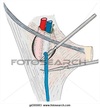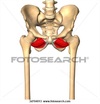Anterior and Medial Thigh Flashcards
Musculovenous pump
muscle contracts, compressing vein and propelling blood toward heart; valves prevent backflow of blood (unidirectional)
How does the fascia of the leg aid the action of the musculovenous pump?
Fascia lata and crural fascia limit expansion of muscles during contraction -> forcing muscle to expand inwards and press on the veins
Deep Vein thrombosis
Thrombosis (clot) in deep vein of lower extremitiy -causes: immobility, hypercoaguability, trauma to vein
Deep fascia forms intermuscular septa that creates what 3 compartments in the thigh and what 3 in the leg?
Thigh: Anterior, Posterior, medial Leg: Anterior, Posterior, Lateral *each associated with own nerve and vessel
Cutaneous innervation of anterior thigh
Lateral cutaneous n. of thigh (branch of femoral n.)
Cutaneous innervation of medial thigh
obturator n.
Arterial and venous supply of anterior thigh
Femoral artery; femoral vein
Arterial and venous supply of medial thigh
Obturator artery, obturator vein
Origin and insertion of Rectus femoris (quadriceps femoris)
O: AIIS
I: patella via quadriceps tendon and indirectly to tibial tuberosity via patellar ligament

Innervation and action of rectus femoris
N: femoral n.
A: extends leg, flexes thigh
Origin and insertion of vastus lateralis (quadriceps femoris)
O: greater trochanter of femur, lateral linea aspera
I; patella via quadriceps tendon and indiretly to tibial tuberosity via patellar ligament

Innervation and action of vastus lateralis
N: femoral n.
A: extends leg
Origin and insertion of vastus medialis (quadriceps femoris)
O: Intertrochanteric line; linea aspera of femur
I: patella via quadriceps tendon and indirectly to tibial tuberosity via patellar ligament

Innervation and action of vastus medialis
N: femoral n.
A: extends leg
Origin and insertion of vastus intermedius (quadriceps femoris)
O: anterior/lateral shaft of femur
I: patella via quadriceps tendon and indirectly to tibial tuberosity via patellar ligament

Innervation and action of vastus intermedius
N: femoral n
A: extends leg
Origin and insertion of pectineus
O: superior ramus of pubis
I: pectineal line of femur

Innervation and action of pectineus
N: femoral n (may receive branch from obturator n)
A: adducts, flexes thigh
Origin and insertion of sartorius
O: ASIS
I: medial surface of proximal tibia

Innervation and action of sartorius
N: femoral n
A: flexes, abducts, and laterally rotates thigh; flexes leg
*sitting cross legged
What three muscles form the pes anserinus
- semitendinosus
- sartorius
- gracilis
What is the femoral triangle?
Passage of structures between abdominopelvic cavity and LE
What are the boundaries of the femoral triangle
SAIL
- Sartorius
- Adductor longus
- Inguinal Ligament

Coming out of the femoral triangle is a opening. What is this called and what vein runs through it?

Saphenous opening; great saphenous v.










